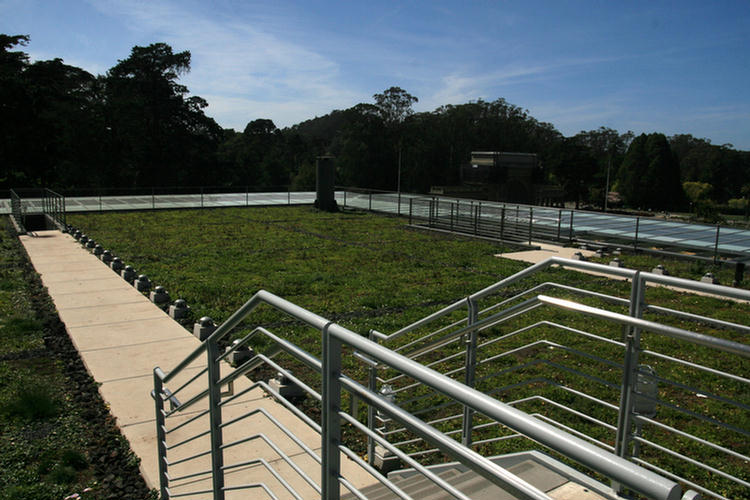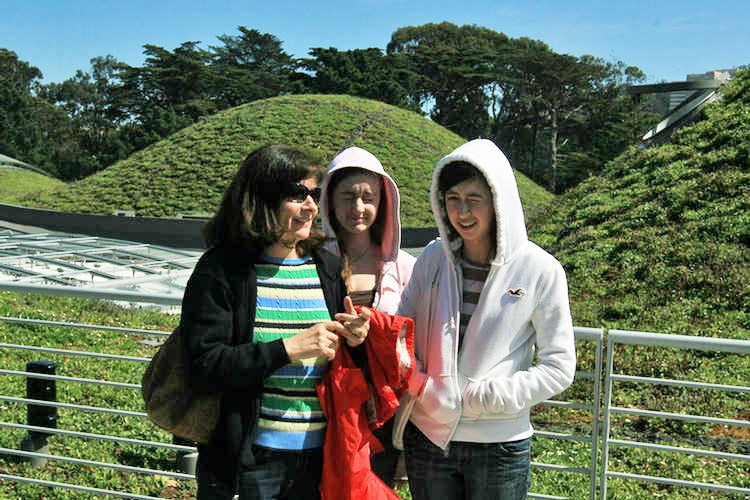The Adademy Of Science Visit Continues
Seeing Science Up Close
The Visit Continues (Page Two)

Junk we throw into the ocean! 100,000,000 chopsticks a year!
Time To Eat At The Moss Room

No other part of the country could produce a restaurant like the Moss Room. Here, in Renzo Piano’s California Academy of Sciences, in the middle of San Francisco’s Golden Gate Park, in what should be the unremarkable basement of one of the country’s largest natural-history museums, the great outdoors have been ushered in.
Squid-shaped swag lamps radiate over wood tables and tawny leather chairs. Cork redolent of bark cloaks a wall behind the bar.
Descending into the restaurant from the Academy’s main floor, you feel as though you’ve landed in some sylvan redoubt, the sort of place California is always naming for John Muir.


The elevator took us down one floor


Hannah and Lisa
Enough Lunch So It Is Time To Explore


We Visited The Planetarium
Did You Know? - The Morrison Planetarium is the largest all-digital dome in the world with a 75-foot diameter projection screen tilted at a 30 degree angle. Thanks to immersive video technology, the dome seems to disappear when imagery is projected onto it, creating an experience more like flying than watching a movie.
The planetarium relies on scientific data to depict current discoveries with unprecedented accuracy. It also has the flexibility to present a wide variety of programming that is both educational and entertaining. Traditional star shows will be supplemented by live “tours of the Universe,” and programming will include live NASA feeds as well as broadcasts from Academy scientists in the field.

It was an amazing 30 minute journey into the cosmos (flash photography not appreciated)
Up On The Roof (No, Not The Song!)

Assembling a 197,000-square-foot rooftop to accommodate a living tapestry of native plant species is challenging enough. Add to that the technical problems posed by the roof's extreme dips and slopes. How to keep the plants and soil from sliding off? Rana Creek, who worked with Piano to design the roof, developed and patented a solution called the BioTray®. They used 50,000 porous, biodegradable trays made from tree sap and coconut husks as containers for the vegetation. These trays line the rooftop like tile, yet enable the roots to grow and interlock, binding the trays together like patchwork.

A view out the front of the building as we make our way to the roof

Did you know? The more typical black tar-and-asphalt building rooftop leads to a phenomenon called the “Urban Heat Island” effect. The endless swath of black rooftops and pavement trap heat, causing cities to be 6 to 10 degrees warmer than outlying greenbelt areas. One-sixth of all electricity consumed in the U.S. goes to cool buildings. The Academy's green rooftop will keep the building's interior an average of 10 degrees cooler than a standard roof would. The plants also transform carbon dioxide into oxygen, capture rainwater, and reduce energy needs for heating and cooling.

The tops open and close based upon prevailing winds, inside temperatures, etc. All computer controlled

The roof is about 24 inches think with dirt, water recovery systems, padding, and other layers to support the growth


Sue and Diane enjoy the wind!
Did You Know? - An open-air observation terrace enables visitors to get a close-up look at the roof’s lush canopy of plants. The view will encompass the densest concentration of native wildflowers in San Francisco. The expansive vista will also become an ideal location for watching Northern California’s birds, butterflies and insects.
Skylights above the larger domes will open and close throughout the day, enabling sunlight to reach the exhibits below. The steep slopes of the rooftop's hills will draw cool air into the open piazza at the center of the building. Weather stations on the roof will monitor wind, rain, and changes in temperature to help inform the automated passive ventilation systems.

"OK, enough with the wind!"

Paul and Diane take in the scenery from four floors up!

Did You Know? - The Living Roof´s 1.7 million native plants were specially chosen to flourish in Golden Gate Park´s climate.
After experimenting with thirty native species, the finalists were all able to self-propagate. They will thrive with little water, resist the salt spray from ocean air, and tolerate wind.

The boxes are placed on the roof and held from slipping by the rock barriers


A large skylight providing light to laboratory and research areas beneath

Solar cells provide 213,000 kwh of energy to the building every year

Up on the roof

A view across the park
Did You Know? - Following a lengthy and dramatic renovation, the California Academy of Sciences is now open. The Academy is seeking to get the building, designed by Renzo Piano, platinum LEED certification, and high atop its qualifications is a 30-foot wide photovoltaic overhang rimming the roof. The system was designed by Quercus Trust-backed solar developer Open Energy of Solana Beach., Calif., and manufactured by Chinese solar giant Suntech.
The solar system sports 60,000 high-efficiency cells sandwiched in 720 4×6 foot panels of Starphire ultra-clear glass from Pittsburgh-based PPG. It is expected to generate 213,000 kilowatt-hours of energy per year, providing up to 10 percent of the academy’s electricity and preventing the release of 405,000 pounds of greenhouse gases into the air
.

Tell me again how this works??
Did You Know? - They used 50,000 porous, biodegradable trays made from tree sap and coconut husks as containers for the vegetation. These trays line the rooftop like tile, yet enable the roots to grow and interlock, binding the trays together like patchwork.

They can be exchanged easily if need be

The rocks form the boundaries and the bio-trays are kept in place by those boundaries

Don't leave the lid up on this building!


it's cool! The teenagers hood is up!

Diane 'splains to Lisa and Hannah

Did You Know? - Living roof technology has been more widely used in Europe than in the United States. But the California Academy of Sciences' Living Roof is unique in its use of native plants (exclusively) and in its unusual and technological design.
The aesthetic of the roof was designed to emulate the hills of San Francisco. It's part of the Academy building's integration with its natural surroundings. The roof provides additional habitat for wildlife as a result of its vast, 2.5 acres of specially selected plants.